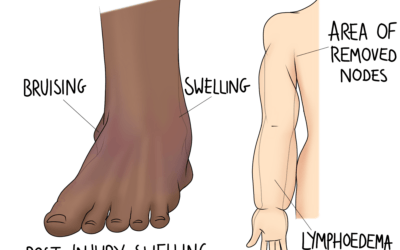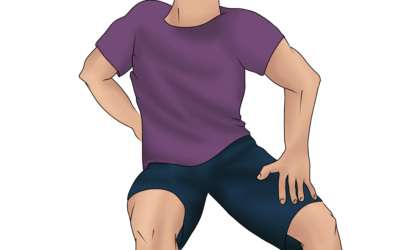Osteopaths are qualified to help with managing minor sports injuries, such as:
- muscle strains
- ligament sprains
- repetitive strain injuries like tennis elbow
We can also help with problems that might bother you at a low level but are aggravated by your sport of choice.
Ligament Sprains
Ligaments are non-contractile bands of tissue that work to limit a joint from moving too far. If a movement is too strong for a ligament, it can overstretch it and cause a sprain. One example of this would be a twisted ankle. There are a few different types of ankle sprain, but typically the injury is due to:
- awkwardly landing on the side of the foot, which asks more of the ligaments on the top and side of the foot
- the majority of your weight then travelling through these ligaments
The severity of the injury is graded on a scale of I to III. A grade I sprain is the least severe, causing only micro-tears within the ligament. A grade III sprain is a total rupture of a ligament: a full width tear. Severity can be assessed clinically based on the degree of swelling and instability.
Because ligaments have a poor blood supply, they take a long time to heal. Your osteopath can help to encourage healing by managing swelling, working to reduce excess load on the area, and helping you with rehabilitation. It is important that you begin to bear weight on a sprained ankle relatively early on in the recovery process, as a small amount of stress helps the fibres to realign properly. It’s hard to find the ideal window for this on your own, so make an appointment soon after your injury so we don’t miss it.
If you’re still feeling the effects from a sprain that happened years ago, we may also be able to help here. Although optimal management will begin before the ligament fibres have knitted back together, we have techniques to stabilise a wobbly joint at any stage.
Sprains Beyond the Ankle
Any ligament can be sprained, not just those in the ankle. Other areas commonly affected by sports injuries include:
- where the collar bone meets the shoulder blade (the acromioclavicular joint)
- ligaments of the wrist
- the elbow
- mild sprains of spinal joints, especially in the neck or lower back
- ligaments in the knee, such as the collateral and cruciate ligaments
Muscle Strains
Muscles strains are similar to ligament sprains in that they are soft tissue injuries, typically caused by overuse or trauma. They are also graded in a similar way, with grade III indicating a full rupture, and grade I referring to more minor damage.
These injuries can be caused by over-stretching like ligament sprains. But they can also be caused by over-contracting. Sudden contraction of a muscle, or contracting with too much force (like lifting a weight that’s too heavy) can cause a strain too.
Mistaken Muscle Strain Injuries
Some injuries can present similarly to other problems. Hamstring strains are a good example of this, as they can behave a little like sciatica. Your osteopath will identify the most likely cause of your pain through your case history and physical examination. Some key differences between a hamstring strain and sciatica are:
- location of pain: hamstring pain is likely localised to a small part of the thigh muscle, whereas sciatica may form a line of symptoms from the lower back to the foot.
- nature of pain: muscle strains can be achey or a bit sharp on movement. Sciatica is typically a more “toothachey”, shooting pain.
- neurological symptoms: both may cause some weakness, but only sciatica causes pins and needles or numbness.
- bruising: a hamstring strain might cause some bruising (which may track away from the injury area), but there is no bruising with simple sciatica.
First Aid for Muscle Strains
Although you should avoid overworking a strained muscle, you should also avoid resting it completely. Movement is good for encouraging blood flow necessary to facilitate healing. It brings in nutrients and takes away waste products. Make sure you stay hydrated, and apply a cool compress in the first 24 hours. An ice pack or bag of frozen peas in a tea towel is ideal- you don’t want to apply ice directly to the skin itself.
Book an appointment with your osteopath to help your recovery. We can advise you on the level of exercise that would be appropriate at your stage in recovery, and give you rehabilitative exercises too. We will also look for compensatory patterns and look to limit the effects of your injury on the rest of the body. If your injury was related to sports, we may also be able to advise a change in technique to reduce the chances of suffering the same injury again.
Repetitive Strain Injuries
Repetitive strain injuries are often low grade muscle strains, caused by repeated innocuous movements rather than one big traumatic one. They can be related to work, such as typing, hairdressing, or using vibrating tools. They can also be caused by the repetitive movements required by some sports. Cricket bowlers may develop shoulder pain as a result of repeated overhead throwing, which can in turn lead to pain into the neck or upper back. When the muscles around the neck and shoulder become tense, they can lead to thoracic outlet syndrome, resulting in pain into the arm. Early intervention to limit the compensatory pattern is ideal. You are welcome to bring in a video of your technique during the action that you believe has caused your pain. We may be able to offer advice on improving your form to avoid straining the area again. We can also identify muscles that may benefit from strengthening exercises as part of your treatment plan.
Tennis elbow can result from sports, and it’s not limited to just tennis. Anything that requires repeated extension of the wrist (bending your wrist back) can overstrain the muscle. Alternatively, sports that require wrist flexion can cause golfer’s elbow, which affects the inside of the elbow instead. Early stage tennis or golfer’s elbow is relatively easy to manage, but when left to progress it can take a lot longer to resolve. The injury has a chance to develop, and lead to inflammation where the bone and muscle meet.
We can also help with soft tissue injuries like this that have nothing to do with sports. If you have similar symptoms as a result of your desk job, we can treat in a similar way. We can also offer advice about ergonomics, ensuring that your desk set up is not contributing to your pain. Whether you work in the office or at home, there are most likely some improvements that can be made quite easily.
Sports Injuries to Cartilage
The cartilage in the hip and shoulder are particularly vulnerable to throwing and dancing injuries, which can cause a labral tear. The labrum is the edge of cartilage on a ball-and-socket joint that protrudes from the joint. It’s role is to provide extra support to the mobile joint, but its position leaves it somewhat exposed to potential injury. Symptoms can be vague, causing generalised pain over the area that is hard to pin down exactly. Pain may also be quite unpredictable, coming and going without a very clear pattern. You may hear or feel a click from the joint on some movements. It might not always be a painful click. As always, the local muscles will likely tighten up to try and protect the area, further altering symptoms by causing additional restriction and ache.
Cartilage in the knee can also be injured through sports like football. The two C-shaped pieces of cartilage within each knee can be torn by rotation, especially if the foot is planted. This kind of movement is not uncommon in kicking sports, as the stabilising leg plants into the floor and the twist of the kick travels through to that knee. Try to avoid twisting through the knee, but if you do develop this injury, keep it as mobile as is comfortable and start applying a cool compress in the early phase. Your osteopath can give more specific advice based on your symptoms.
Like ligaments, cartilage has a poor blood supply, and longer healing times as a result. Cartilage injuries should not be immobilised, but aggravating movements should be avoided where possible. As the area heals, we can advise you about reintroducing those movements in a safe way. Movement is important to encourage the fluid in the joint to refresh, as this is how the cartilage gets its nutrients in and removes its waste products. Your osteopath might also want you to try contrast bathing, or hot and cold therapy. This entails applying a warm and cool compress one after the other to encourage blood flow to the area and back away again. Your treatment plan will be tailored for your exact case, so make an appointment below to get started.
Click here to book an appointment in Leeds for your sports injuries.




0 Comments